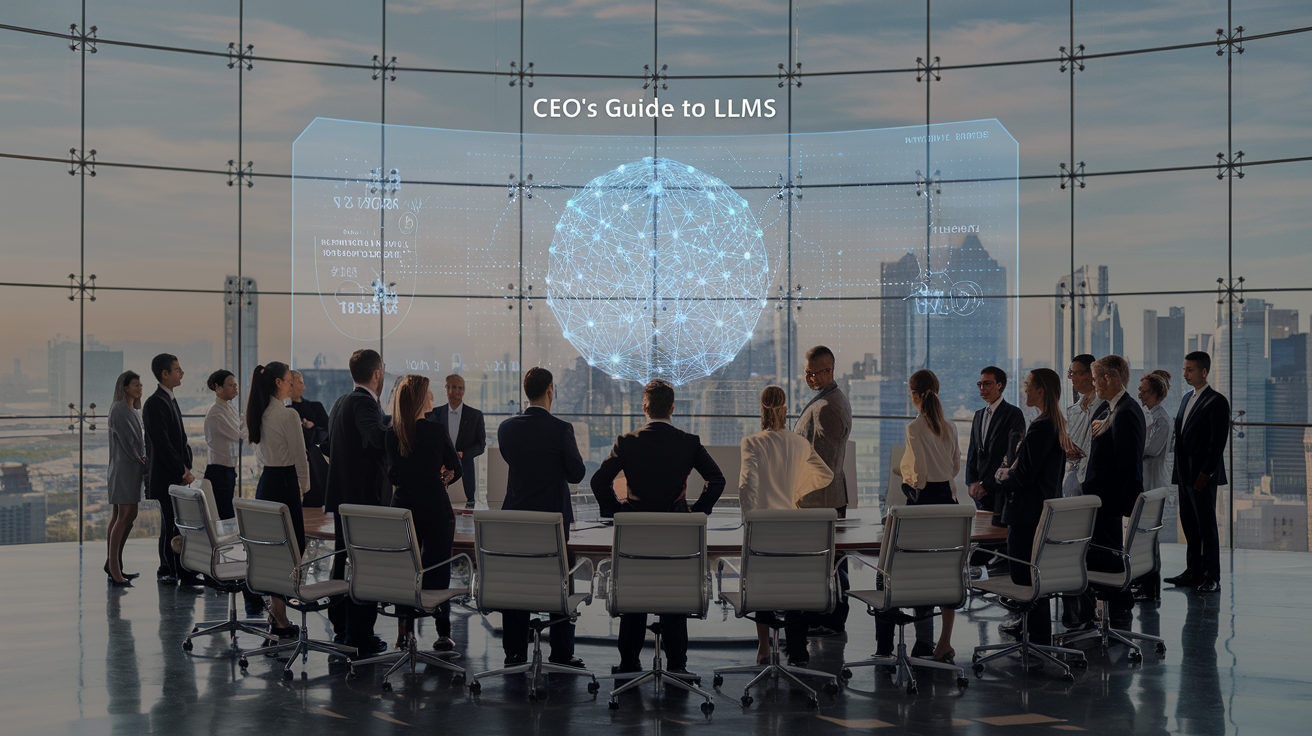Have you ever wondered how AI could revolutionize your business? Well you have landed in the right place for answers. Large Language Models (LLMs) are at the forefront of this AI revolution, and as a CEO, you can’t afford to be left behind. These powerful tools are reshaping industries, automating complex tasks, and unlocking new possibilities for innovation and growth.
While LLMs offer incredible potential, they also bring challenges and ethical considerations that every leader must navigate. How can you harness the power of LLMs to drive your business forward while mitigating risks? This guide is your roadmap to understanding, implementing, and leveraging LLMs in your organization.
From grasping the basics of LLMs to exploring their business applications, we’ll walk you through everything you need to know. You’ll discover how to implement these models in your organization, tackle ethical considerations, and future-proof your business in an AI-driven world. Are you ready to transform your company with the power of LLMs? Let’s get started.
Understanding LLMs: The Basics
What are Large Language Models?
Large Language Models (LLMs) are advanced artificial intelligence systems that have revolutionized the way we interact with and process natural language. As a CEO, understanding these powerful tools is crucial for staying ahead in today’s rapidly evolving business landscape.
LLMs are neural networks trained on vast amounts of text data, enabling them to understand, generate, and manipulate human language with remarkable accuracy. They can perform a wide range of tasks, from answering questions and translating languages to writing code and generating creative content.
Key features of LLMs include:
- Natural language understanding
- Context-aware responses
- Multi-task capabilities
- Scalability across various industries
By leveraging these capabilities, you can unlock new opportunities for innovation and efficiency within your organization.
Key players in the LLM space
As you explore the world of LLMs, it’s essential to familiarize yourself with the major players shaping this technological landscape. Some of the most prominent LLMs and their creators include:
- GPT (Generative Pre-trained Transformer) series by OpenAI
- BERT (Bidirectional Encoder Representations from Transformers) by Google
- LaMDA (Language Model for Dialogue Applications) by Google
- PaLM (Pathways Language Model) by Google
- Claude by Anthropic
- LLaMA (Large Language Model Meta AI) by Meta
- Grok 3 by xAi
Each of these models has its unique strengths and applications, and staying informed about their developments can help you make strategic decisions for your business.
How LLMs are transforming industries
The impact of LLMs extends far beyond the tech sector, revolutionizing various industries and creating new opportunities for growth and innovation. As a CEO, recognizing these transformations can help you position your company for success in the AI-driven future.
LLMs are reshaping industries in several ways:
- Customer service: Enhancing support with intelligent chatbots and virtual assistants
- Healthcare: Assisting in medical research, diagnosis, and personalized treatment plans
- Finance: Improving risk assessment, fraud detection, and market analysis
- Marketing: Generating personalized content and optimizing campaigns
- Legal: Streamlining document review and contract analysis
- Education: Providing personalized learning experiences and automated grading
By understanding how LLMs are transforming these industries, you can identify potential applications within your own sector and gain a competitive edge.
Business Applications of LLMs
Enhancing Customer Service with AI Chatbots
AI-powered chatbots, driven by LLMs, are revolutionizing customer service. You can implement these advanced chatbots to:
- Provide 24/7 support, addressing customer queries instantly
- Handle multiple conversations simultaneously, reducing wait times
- Offer personalized responses based on customer history and preferences
- Escalate complex issues to human agents seamlessly
By integrating LLM-powered chatbots, you’ll not only improve customer satisfaction but also reduce operational costs associated with traditional customer service methods.
Improving Content Creation and Marketing
LLMs are transforming the way you approach content creation and marketing. Here’s how you can leverage them:
- Generate high-quality, SEO-optimized blog posts and articles
- Create engaging social media content tailored to specific platforms
- Develop personalized email campaigns at scale
- Produce product descriptions and marketing copy efficiently
With LLMs, your marketing team can focus on strategy and creativity while AI handles the time-consuming task of content generation.
Streamlining Data Analysis and Insights
As a CEO, you understand the importance of data-driven decision-making. LLMs can significantly enhance your data analysis capabilities by:
- Summarizing large volumes of data into concise, actionable insights
- Identifying trends and patterns that might be missed by human analysts
- Generating natural language reports from complex datasets
- Answering specific questions about your business data in plain language
By implementing LLMs for data analysis, you’ll empower your team to make faster, more informed decisions based on comprehensive insights.
Automating Repetitive Tasks
One of the most valuable applications of LLMs is their ability to automate various repetitive tasks across your organization. You can use LLMs to:
- Draft and proofread routine emails and documents
- Summarize meeting notes and create action items
- Generate code snippets for software development
- Translate documents and communications into multiple languages
By automating these tasks, you’ll free up your employees’ time, allowing them to focus on higher-value activities that require human creativity and problem-solving skills.
As we move forward, it’s important to consider how to effectively implement these LLM applications in your organization. The next section will guide you through the process of integrating LLMs into your existing business infrastructure.
Implementing LLMs in Your Organization
Assessing your company’s AI readiness
Before diving into LLM implementation, you need to evaluate your organization’s readiness for this advanced technology. Consider the following factors:
- Technical infrastructure: Do you have the necessary hardware and software to support LLMs?
- Data quality and quantity: Is your data sufficient and well-organized for LLM training?
- Skill set of your team: Do you have AI-savvy professionals or the capacity to train them?
- Organizational culture: Is your company open to AI-driven innovation and change?
Choosing the right LLM for your needs
With numerous LLMs available, selecting the most suitable one for your business is crucial. You should consider:
- The specific tasks you want to accomplish
- The level of customization required
- The model’s performance metrics
- Cost and resource requirements
Integration strategies and best practices
Implementing LLMs requires a well-thought-out strategy. You should:
- Start with a pilot project to test the waters
- Develop a clear roadmap for scaling LLM usage
- Establish guidelines for responsible AI use
- Regularly evaluate and fine-tune your LLM applications
Overcoming implementation challenges
As you integrate LLMs, you’ll likely face obstacles. Be prepared to address:
- Data privacy and security concerns
- Potential biases in LLM outputs
- Integration with existing systems and workflows
- Managing stakeholder expectations
Training your team on LLM usage
To maximize the benefits of LLMs, your team needs to be well-versed in their use. Consider:
- Providing comprehensive training programs
- Encouraging experimentation and innovation
- Establishing best practices for LLM interaction
- Regularly updating skills as LLM technology evolves
Now that you’ve laid the groundwork for LLM implementation, it’s crucial to consider the ethical implications and potential risks associated with this powerful technology.
Ethical Considerations and Risks
Data privacy and security concerns
As you explore the potential of LLMs for your business, it’s crucial to address the associated data privacy and security concerns. These powerful AI models often require vast amounts of data to function effectively, which can pose significant risks if not managed properly. Here are key considerations:
- Data collection and storage: Ensure that your organization has robust protocols for collecting and storing data used to train or interact with LLMs.
- Data anonymization: Implement strong anonymization techniques to protect individual privacy when using customer or employee data.
- Access control: Establish strict access controls to limit who can interact with the LLMs and the data they process.
- Encryption: Use end-to-end encryption for data in transit and at rest to prevent unauthorized access.
Bias and fairness in AI models
LLMs can inadvertently perpetuate or amplify biases present in their training data. As a CEO, you must be proactive in addressing these issues:
- Diverse training data: Ensure that the data used to train your LLMs is diverse and representative of various demographics.
- Regular audits: Conduct frequent audits of your AI models to identify and mitigate potential biases.
- Fairness metrics: Implement fairness metrics to measure and monitor the performance of your LLMs across different groups.
Transparency and explainability issues
The complexity of LLMs often makes it challenging to understand how they arrive at specific outputs. This lack of transparency can be problematic, especially in decision-making processes. To address this:
- Explainable AI techniques: Implement explainable AI techniques to provide insights into the model’s decision-making process.
- Clear documentation: Maintain comprehensive documentation of your LLM’s architecture, training process, and decision-making criteria.
Regulatory compliance and legal implications
As you integrate LLMs into your business operations, it’s essential to stay ahead of regulatory requirements and potential legal issues:
- GDPR and other data protection laws: Ensure compliance with relevant data protection regulations in all jurisdictions where you operate.
- Intellectual property considerations: Be aware of potential copyright issues when using LLMs to generate content or analyze proprietary information.
- Liability concerns: Understand the legal implications of decisions made based on LLM outputs and establish clear accountability frameworks.
By addressing these ethical considerations and risks, you’ll be better positioned to harness the power of LLMs responsibly and sustainably. Next, we’ll explore how to future-proof your business with these transformative technologies.
Future-Proofing Your Business with LLMs
Staying ahead of LLM advancements
To future-proof your business with LLMs, you need to stay informed about the latest advancements. Consider these strategies:
- Subscribe to AI-focused publications and newsletters
- Attend industry conferences and webinars on LLMs
- Establish partnerships with AI research institutions
- Invest in ongoing training for your technical teams
By keeping your finger on the pulse of LLM developments, you’ll be better positioned to leverage new capabilities as they emerge.
Fostering a culture of AI innovation
Creating an environment that embraces AI innovation is crucial for your organization’s long-term success. You can:
- Encourage experimentation with LLMs across departments
- Set up cross-functional teams to explore AI applications
- Implement reward systems for AI-driven improvements
- Provide resources and time for employees to learn about LLMs
This approach will help your company adapt quickly to new LLM technologies and find innovative ways to apply them to your business processes.
Preparing for the impact on workforce dynamics
As LLMs continue to evolve, they will undoubtedly affect your workforce. To prepare for these changes:
- Identify roles that may be augmented or replaced by LLMs
- Develop reskilling and upskilling programs for employees
- Create new positions that focus on AI integration and management
- Communicate transparently about the role of LLMs in your organization
By proactively addressing workforce concerns and opportunities, you’ll ensure a smoother transition as LLMs become more integrated into your business operations.
Here’s to the future!
As a CEO, embracing Large Language Models (LLMs) can propel your organization into a new era of efficiency and innovation. From understanding the basics to exploring diverse business applications, you now have insight into how LLMs can transform various aspects of your operations. By implementing these powerful tools strategically and addressing ethical considerations, you’re poised to unlock unprecedented value for your company.
Make sure to stay informed about emerging trends, invest in continuous learning, and foster a culture of innovation within your organization. By doing so, you’ll not only adapt to the rapidly evolving landscape of AI but also position your company as a leader in leveraging LLMs for sustainable growth and competitive advantage.




